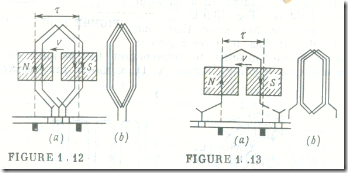Drum Armature Windings ,
The conductors placed in the armature slots must be interconnected in a proper way so as to make up the armature winding.
Most of the present-day d.c. machines use a drum armature which is a cylinder (see Fig. 13.3) assembled from electrical-sheet steel laminations insulated from one another. The sides of each turn in
a drum winding are spaced approximately a full pitch, t. apart, so that the emfs induced in both sides of a turn will combine. In this way, each turn encloses nearly all of the flux in one pole of a machine. Sometimes, short-pitch turns are used, that is, those in which the width of a turn is less than the pole pitch. This is done in order to reduce the size of the coil ends.
Instead of one turn the slots usually receive multiturn coils (Fig. 1.12 b). The coils may be connected to form a complete armature winding in any one of two basic ways. With one the resui is what is called a lap winding: for connection to the next coil, the first must return to the pole from which it started, so the coil thro*’ is bar 1, to bar 2, to bar 3, etc. In a diagram, the individual conductors are not shown, but only the coil sides. The brushes divide a lap winding into as many parallel circuits as there are poles, so for a machine having a lap winding a = p.
The other way of connection results in what is called a wave winding (Fig- 1.13 a). Now the coil (see Fig. 1.13 b) lying under one pole is connected to the next one around the circumference of the armature. The number of parallel circuits in the case of a wave (or, rather a simple wave) winding is two (2a = 2), no matter how many poles the machine has. For a simple wave winding to close upon itself, one has to go round the circumference of the armature several times. A lap winding closes on itself first time around the armature.
The simple wave winding is used on small and medium machines (not over 500 kW) at a voltage of 110 V and higher. The simple lap winding is used on small-size two-pole machines (not over 1 kW) and on machines in sizes up to 500 kW.
Multiplex windings are formed by placing m simple windings in the armature slots; as a result, the number of parallel circuits is increased m times. Multiplex (or multiple) windings are used on large machines.

